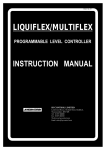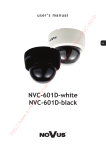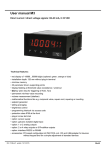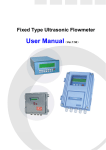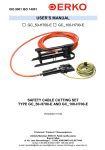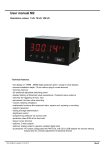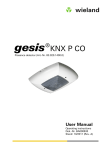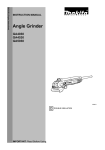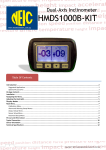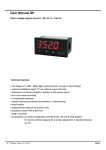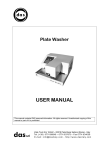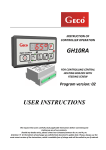Download MPI-D, MPI-DN
Transcript
MPI-D, MPI-DN Multi-channel electronic recorder USER’S MANUAL Rev: 2015-01-28 This User’s Manual is available also in digital version on CD-ROM. MPI-D / MPI-DN Safety Information ! To ensure the recorder is installed and used safely, follow all instructions stated in this Manual. Incorrect installation of the recorder may cause serious health hazard and can be life threatening. The recorder has been manufactured according to the requirements of relevant EU directives. The recorder must not be installed in explosive environments. Information from the Manufacturer All functions of the recorder are subject to modifications for the benefit of technical progress. HART® is a registered trademark of HART Communication Foundation, Austin, Texas, USA MODBUS® is a registered trademark of Modbus Organization, Inc., North Grafton, MA 01536 USA 2 MPI-D / MPI-DN TABLE OF CONTENTS 1. PURPOSE AND APPLICATION SCOPE OF THE DEVICE ........................................ 6 1.1. Purpose ................................................................................................................ 6 1.2. Available versions ............................................................................................... 6 1.3. Basic functions .................................................................................................... 7 2. MAINTENANCE OF THE DEVICE ............................................................................... 9 2.1. Front panel ........................................................................................................... 9 2.1.1. Display organization ....................................................................................... 9 2.1.2. Functional buttons ........................................................................................ 11 2.1.3. LED indication .............................................................................................. 11 2.1.4. USB port ....................................................................................................... 12 2.1.5. Data upload to USB flash drive .................................................................... 12 2.2. Analog output 4-20mA ...................................................................................... 13 2.3. Communication with the master system ......................................................... 13 2.3.1. Port RS-485 (2) ............................................................................................ 13 2.3.2. Ethernet port................................................................................................. 13 2.4. Display................................................................................................................ 14 2.4.1. Individual screens ......................................................................................... 14 2.4.2. Summary screens ........................................................................................ 16 2.4.3. Special screens ............................................................................................ 17 2.5. Messages ........................................................................................................... 18 2.6. Failure symbols ................................................................................................. 18 2.7. Authorized functions, user login and logout .................................................. 18 2.7.1. Changing password by the user / administrator ........................................... 20 2.8. Archive control .................................................................................................. 20 2.8.1. Create new Archive File. .............................................................................. 20 2.8.2. Starting, resuming and stopping archiving.................................................... 21 2.8.3. Memory usage indicator ............................................................................... 21 2.9. Browse measurement results recorded in the Archive .................................. 22 2.10. Totaliser Archive ............................................................................................... 23 2.11. Alarms and control ............................................................................................ 23 2.12. Control functions ............................................................................................... 24 2.13. Failure notification of measurement inputs .................................................... 24 2.14. User characteristics - nonlinear characteristics of measurement transmitter 24 2.15. Audit trials .......................................................................................................... 25 2.15.1. Totaliser Log................................................................................................. 25 2.15.2. Event Log ..................................................................................................... 26 2.15.3. Authorization Log ......................................................................................... 26 2.15.4. Logs browsing on device display .................................................................. 27 2.15.5. Event Log Files and Authorized Operations Log Files .................................. 27 2.15.6. Remote reading of the Log ........................................................................... 28 3. INTERNAL DATA MEMORY ..................................................................................... 29 4. TECHNICAL DATA .................................................................................................... 30 3 MPI-D / MPI-DN 5. COMPLETE DELIVERY AND ACCESSORIES ......................................................... 35 5.1. Content of MPI-D ............................................................................................... 35 5.2. Content of MPI-DN ............................................................................................. 35 5.3. Accessories ....................................................... Błąd! Nie zdefiniowano zakładki. 6. ENTITY LAUNCHING THE PRODUCT ON EUROPEAN UNION MARKET BŁĄD! NIE ZDEFINIOWANO ZAKŁADKI. 7. ASSEMBLY AND INSTALLATION ..................................................................... 37 7.1. Assembly............................................................................................................ 37 7.2. Electrical connections ...................................................................................... 38 7.3. Galvanic separation .......................................................................................... 39 7.4. Power connection.............................................................................................. 39 7.5. Connecting transmitters to the RS-485 (1) port .............................................. 40 7.6. Connecting transmitters to the HART port...................................................... 41 7.7. Connecting the MPI-D device as Secondary Master ...................................... 41 7.8. Connect signals to binary inputs ..................................................................... 42 7.9. Analog output 4-20mA connection .................................................................. 43 7.10. Connecting receivers to binary outputs (RL1 to RL4) .................................... 43 7.11. Connecting to RS-485 (2) data transmission line ........................................... 44 7.12. Connecting the device to the LAN using the Ethernet port ........................... 46 7.13. USB port ............................................................................................................. 46 8. DEVICE CONFIGURATION ................................................................................. 47 8.1. Order of settings during configuration ............................................................ 47 8.2. Administrator login (ADMIN) ............................................................................ 48 8.3. Relay outputs RL1…RL4 ................................................................................... 50 8.4. Configuration of HART and RS-485(1) inputs ................................................. 51 8.5. Configuration of binary PULS type inputs ..................................................... 54 8.6. Math channels.................................................................................................... 56 8.7. Failure signaling of measuring transducers ................................................... 57 8.8. Alarms and control thresholds......................................................................... 58 8.9. Totalisers............................................................................................................ 60 8.10. Nominal month beginning ................................................................................ 63 8.11. 4-20mA current loop output (optional) ............................................................ 63 8.12. Archiving of the results in the internal memory. ............................................ 63 8.13. Totalisers Archive ............................................................................................. 64 8.14. RS-485 port (2) ................................................................................................... 65 8.15. Text messages ................................................................................................... 66 8.16. Ethernet Port ...................................................................................................... 66 8.17. Display configuration ........................................................................................ 67 8.18. Device description............................................................................................. 69 8.19. Summer and winter time - automatic adjustment ........................................... 69 8.20. Saving to and loading settings from a file....................................................... 69 9. FUNCTIONS AVAILABLE ONLY FOR AN ADMINISTRATOR .......................... 71 9.1. Changing the Administrator Password ........................................................... 71 9.2. Administrator menu .......................................................................................... 71 9.3. New firmware and licence granting ................................................................. 72 4 MPI-D / MPI-DN 9.4. 9.5. 9.6. Restoring factory settings ................................................................................ 73 Test of communication ..................................................................................... 73 Functions available only for service ................................................................ 73 10. TEST FUNCTIONS ......................................................................................... 75 10.1. Test of communication ..................................................................................... 75 10.2. Port RS-485 (2) monitor .................................................................................... 76 11. MPI-DN - WALL-MOUNTED VERSION .......................................................... 77 11.1. Housing .............................................................................................................. 77 11.2. Connection of the electrical signals in the instrument MPI-DN..................... 78 11.3. Extended keyboard. .......................................................................................... 79 12. MPI-C-RAPORT RESULTS VISUALIZATION SOFTWARE ............................ 80 13. MODBUS RTU AND MODBUS TCP PROTOCOL .......................................... 81 13.1. Serial port settings RS-485 for Modbus RTU .................................................. 81 13.2. Ethernet port settings for Modbus TCP ........................................................... 81 13.3. Readout of current results and totalisers........................................................ 82 13.3.1. Register addresses for current results .......................................................... 82 13.3.2. Register addresses for totalisers .................................................................. 84 13.4. Readout alarm threshold exceedances – function 02 .................................... 88 13.4.1. Numbers of bits for reading out alarm threshold exceedances..................... 89 13.5. Reading out archives ........................................................................................ 90 13.5.1. Registers’ addresses for readout of archive of current results...................... 91 13.5.2. Registers’ addresses to which recording is possible. ................................... 92 13.6. Readout and settings of clock.......................................................................... 93 13.6.1. Registers’ addresses of clock ....................................................................... 93 13.7. Function 08 (Diagnostics) ................................................................................. 94 Sections marked with attached to the recorder. are available only in the CD-ROM version of this Manual Instructions significant for the correct operation of the device are marked with 5 ! MPI-D / MPI-DN 1. PURPOSE AND APPLICATION SCOPE OF THE DEVICE 1.1. Purpose MPI-D and MPI-DN are versions of a multi-channel microprocessor-based measuring device with electronically recorded measurement results. The recorder is intended to measure process values in industrial applications. It is designed to work with devices and sensors that communicates by digital bus: RS-485 standard with Modbus RTU protocol, HART standard (also In multidrop configuration). With the special structure of the processing route applied, this recorder is perfectly suited for slow variable runs with changes taking place at a few seconds intervals. Extended functions of events and process values recording make it possible to perform analysis of technological processes and emergency conditions. Data recording of process values enables to use this device in places beyond the reach of computer networks. Four output relays provide with signalling and simple controlling. 1.2. Available versions The device is manufactured in two different casings – for panel mounting (MPI-D) and wall mounting (MPI-DN). Both versions have the same metrology functions. MPI-D version require 24 V AC/DC power supply, and MPI-DN version is adapted to be powered from 24 V AC/DC or 230 V AC. Optionally both versions can be equipped with an analog output 4-20mA. Offered versions of the devices: MPI-D MPI-DN -x -0 -1 version without analog aoutput 4-20mA version with analog aoutput4-20mA -x -0 -1 version without analog aoutput 4-20mA version with analog aoutput 4-20mA Devices are available in four language versions: Polish, English, French, German. Language change is available from the device keyboard. ! Due to the slight differences between the versions of MPI-D and MPI-DN manual describes the version of the MPI-D. Information about differences in MPI-DN are given in Chapter 10. 6 MPI-D / MPI-DN 1.3. Basic functions Measuring channels MPI-D can display up to 20 measuring channels. 18 channels is used to read the digital HART protocol (only PV - primary variable, SV - secondary variable, TV - third variable FV - fourth variable), or Modbus RTU via RS-485 (1) port. The remaining two channels are used to display PULS inputs. PULS-type inputs can operate in one of three modes: o binary inputs mode, can trace circuit closing/opening, each of the two binary states(conditions) can be assigned to any analog value (e.g. -1.00 / 10.0), value corresponding to binary state can be used in simple controlling operations or as a value in calculated values (e.g. flow direction); o frequency measure mode, in range between 0.001 Hz and 10 kHz, programmable frequency range allows the scaling of the measured value to engineering units (e.g. flow); o pulse counting mode, should be selected if a transmitter with constant pulse weight is connected to the binary input. PULS inputs can be connected with binary pulse transmitter (contact, transistor in OC configuration), the source of voltage or current pulses and in the NAMUR standard. Calculated values Based on the measurement results, intermediate values can be calculated and defined with user-specified formulas. The recorder handles addition, subtraction, multiplication, division and extraction of roots, as well as multiplication or addition of a fixed value. You can add channel values (e.g. to define the total value of several flows), calculate arithmetic or geometric mean (e.g. average temperature), compare two values (e.g. percentage share of either of two compared flows), difference (e.g. pressure difference between two independent pressure sensors). There are 16 calculation channels available that offer the same functions as measuring channels and can support alarm, control and recording functions. Totalisers Each measurement input (incl. binary inputs) and each calculated value have two independent totalisers assigned. Totalisers can measure slow variable flows, etc. Totalisers for pulse inputs can provide precise pulse aggregation. For channels 1 to 18 values of totalisers can be read via HART and Modbus RTU port as well. Results recording Measurement and calculation results as well as totaliser readings can be recorded in the recorder’s internal memory with the capacity of 2 GB. Data are saved as text files protected with encoded checksum. Apart from the measured values, the recorder also saves events (power loss, resetting, exceeded threshold values, etc.) and authorized operations. Internal memory can save up to 250 files. Results displaying Measurement results can be displayed on the recorder screen or moved to a PC. There is a backlit TFT LCD display and three tri-color LEDs on the face plate. Depending on the configuration, the measurement and calculation results are displayed as large digits, analog information or graphs. The results can be also displayed collectively as 7 MPI-D / MPI-DN tables or bar charts. Measurement screens can be browsed sequentially or set to a selected channel. Functional buttons MPI-D has seven functional buttons. Buttons can have different functions, depending on the currently displayed information. They allow to fully configure the device. MPI-DN device have an extended 19-button keypad. The key functions can be protected with a password and user name. Relay outputs Four solid-state output relays which can be assigned to alarm and control thresholds, allow to implement a signalization of exceedance and a simple two-state control. Relays can also be configured to work as pulse outputs. Then a relay is assigned to one of the available totalisers. Number of pulses corresponds to totaliser incrementation. Analog output 4-20mA (optional) The instrument can be equipped with an analog 4-20mA current loop output. This output can trace the channel value (measured or calculated) in range set by user. The current loop can be powered from a device with an internal voltage source +24 V or from an external voltage source. The current output is galvanically isolated from other circuits in device. The output is optionally assembled Communication with a computer system The instrument can be incorporated into the master computer system by: o built-in serial RS-485(2); available ASCII and Modbus RTU protocol, o Ethernet port (web server). Supplementary software (optional) Additional MPI-C-Raport software facilitates the recorded results overview and handles basic mathematic processing and data selection. 8 MPI-D / MPI-DN 2. MAINTENANCE OF THE DEVICE Face plate 2.1. Front panel 2.1.1. Display organization The display along with buttons is a basic element of communication between the device and a user. It displays following information: results of measurements, messages, archive menu, settings menu, pictograms of the function buttons (keypad). Display can be divided into three main areas: 1) area of results , 2) area of pictograms of three lower function buttons , 3) area of pictograms of four side function bottom. Pictograms of measuring channels: channel 01 channel 03 9 MPI-D / MPI-DN Other channels as above. Additional screen pictograms: „Main archive” „Data and time” „Relay outputs” „Threshholds” „Bar chart” „Table” Summary screen pictograms: „Table” defined by user Measurement screen pictograms: “Large digits” – digital display with large digits “Trend graph” – graphical display of data “Bar graph” – display with an analog line „Min, max” – minimum / maximum / average values in a table „Min, max” – minimum / maximum / average values in an analog line 10 MPI-D / MPI-DN Other pictograms: Settings – return to the MAIN MENU and settings Full screen display (archive browsing) Help – help function call and additional information Recorder name, firmware version, serial number and recorder description (can be edited by user) „Exit” – exit to the previous menu or abandoning an operation „Enter” – go to the next menu , 2.1.2. „OK” – confirm a message or accept an operation Functional buttons There are 7 (MPI-D) or 19 functional buttons (MPI-DN, see section 10.3) on the front panel. Each function button can perform different actions depending on an operational state of the flow computer and information displayed on the screen. To simplify a handling of the device, on the screen are displayed pictograms which symbolize buttons functions active at the moment. 2.1.3. LED indication On a front panel are located three LEDs marked as: ALARM – when the device is in an alarm state it lights up in red (constantly or blinking), it is accompanied by a message explaining the cause of the alarm, green color reminds to log out after completing authorized operation REC – constant green light indicates recording data into an internal memory, pulsing green light indicates opening/closing a file, red color indicates an error in the archive function. USB – it lights up in orange when USB controller is on, green-orange flashing indicates reading/recording data, red light indicates an error (e.g. lack of USB flash drive during reading/writing data). 11 MPI-D / MPI-DN 2.1.4. USB port The USB port socket is located on the face panel and is intended for connecting an external mass storage device (USB flash drive). ! MPI-D cannot support advanced directory and subdirectory structure that can be saved on an USB flash drive. It is recommended to use a suitable USB mass storage device (USB flash drive) that can be supported by the recorder. Yellow USB LED is lit when the external USB memory controller is ON, green and red blinking LED means that data are recorded or read, red continuously lit LED signals an error (e.g. absence of mass storage device when the recorder attempts to save / read data). USB port ! If the mass storage device is disconnected from the USB port when the USB LED is lit (yellow and green-red), all data saved on the mass storage device can be lost. 2.1.5. Data upload to USB flash drive In order to copy files to a USB mass storage device, go to → Main menu → Copy files. Select Current archives to copy the current archive file, totaliser archive file and log files. Select Choose file to be able to select files from a list. When the files are being copied, the USB mass storage device must be plugged into the USB socket. The ‘copy’ function can be password-protected and available to authorized users only. Files can be also moved or deleted. Note that specific files are accessible to SERVICE users only. To read data, plug the USB flash drive into USB port on a PC. The mass storage device will be displayed as an additional computer disc, and the data will be saved as text files. 12 MPI-D / MPI-DN Mass storage device (USB flash drive) 2.2. Analog output 4-20mA The device can be equipped with the optional analog output 4-20mA. The output can trace a signal linearly dependent on the value chosen from the reading values, which is measured or calculated. The output range have to be set during configuration and assign to one of the channels. The output cannot trace the totaliser. 2.3. Communication with the master system MPI-D device can communicate with the master system through: RS-485 (2) - ASCII and Modbus RTU protocols; Ethernet port - Modbus TCP protocol, Web server. ! The communication via the RS-485 (2) port have no effect on communication via the Ethernet port and vice versa. 2.3.1. Port RS-485 (2) The following data can be remotely accessed via RS-485 port: current results (ASCII and Modbus RTU), the archive of the current results (the most recent file only, ASCII and Modbus RTU), 500 recently recorded events (ASCII only), 500 recently recorded authorized operations (ASCII only), totaliser files, event log and authorized operations log (ASCII only), status and information about the current results recorded in the archive (ASCII and Modbus RTU), recording control (start, stop etc., ASCII only). Connecting GSM module to RS485(2) port enables to transfer as a text messages (SMS) information about selected alarms and failures and measurement values and totalisers. 2.3.2. Ethernet port The device features an Ethernet communication module with Modbus TCP protocol to connect the recorder to a master computer (PC, PLC) via industrial Ethernet network. The following data can be remotely accessed via Ethernet port: current results, the archive of the current results (the most recent file only), 13 MPI-D / MPI-DN status and information about the current results recorded in the archive. Fig. 2.1 Ethernet Port In Modbus TCP the Ethernet module can open simultaneously up to 4 connections. Thus, it is possible to query the device from 4 different computers or systems. Data from measuring channels are available in two formats: Integer and Floating point. For Ethernet port also a web server is available by IP address in the standard browser. In this way it is possible to monitor all measurement and math channels, totalisers, check the status of the analog output and relay outputs as well as visualize the obtained data in a graph representation (TREND). User can select Settings button to define channels to be displayed on the graph and to change the trend line color and the refreshing time of the graph. The web server is available in four languages: English, German, French and Polish. The read-outs of data and the number of connected clients (up to 4) via the Ethernet port have no effect on the communication via the RS-485 port. ! The web site was tested with Explorer 8, Opera, Mozilla Firefox, Chrome and Safari browsers. 2.4. Display 2.4.1. Individual screens Measurement and calculation results can be displayed in six various forms, as measurement screens. 1. „Large digits” – measuring channel number and results are displayed in large, easy to read digits (approx. 12 mm) along with channel description and unit. 14 MPI-D / MPI-DN 2. „Trend graph” – graphic representation of the measured quantity with results displayed on a time graph (for at least 353 recent measurement points) along with digital read-out of instantaneous value and unit. Alarm / control thresholds are displayed on the graph (if set for the relevant channel), and the instantaneous value is displayed in the assigned color after a specific threshold is exceeded (yellow in the shown example). With button, you can monitor the time axis scale and graph value. 3. „Bar graph” (analog line) – digital result along with a unit and description and an analog line indicating the location of an instantaneous read-out against a pre-defined scale; the analog line also shows the points of alarm/control thresholds (if set). 4. „Min, max” (minimum, maximum, average) – digital result along with a unit and description and a table with minimum, maximum and average values saved, and the date and time of the beginning of calculation. Use to reset the values. A password might be required. 5. „Min, max (bar)” – digital result along with a unit and description and an analog line (bar graph) indicating the minimum, maximum and average value against a predefined analog scale. Likewise, use to reset the values. This function might be pass-word protected. 6. „Totalisers” – digital result along with a unit and description and the totaliser status. Use to reset one or both totalisers. This function might be passwordprotected. ! When setting the parameters, you can also select the way the results are displayed and switch off specific measurement screens. It is easier to operate the recorder by limiting the number of superfluous functions. One of the active screens can be set to a "default screen" displayed when a specific measuring channel is selected. Each channel can have a different number of screens and a different default screen assigned. Measuring channels can be browsed manually or can be displayed in a sequence. 15 MPI-D / MPI-DN Manual channel selection: To select a measuring channel, use the middle buttons from the four side buttons (,). Press and release a button to display the next measuring channel. The available channel number is indicated with the button icon. In the manual mode, all enabled channels are available. Auto-browsing of channels: Press and hold the channel selection button (,) when browsing through measurement screens to switch to automatic display of measurement results from subsequent channels, in an ascending or descending manner, respectively. Only channels set to Auto-browse YES under device settings will be displayed in the automatic mode. You can now browse through a selection of only the most important channels shown in a sequence. The remaining channels are available in the manual mode. To disable the “auto” mode, press and release any button. Changing measurement screens: Use the middle and the right button from a group of three buttons at the bottom of the display to change the measurement screen. Only screens defined as Visible or Primary under device settings are available. You can set different screens for each channel. The next available screen is indicated with the button icon. 2.4.2. Summary screens Apart from individual screens and special screens, summary screens are also available. One can define up to 6 tables, and each of the tables (depending on the type: uppercase or lowercase) can include 6 or 3 results (measurement results, calculation results, totalisers). 1. „Table” – defined by user, featuring three result lines. The table names can be edited by the user. 2. „Table” – defined by user, featuring six result lines. Summary screens are available in the manual and sequence mode. Press the next/previous table. to go to Auto-browsing of summary screens: Press and hold the channel selection button (,) when displaying summary screens to go to automatic display of subsequent tables, in an ascending or descending manner, respectively. Only tables set to Auto-browse YES under device settings will be 16 MPI-D / MPI-DN displayed in the automatic mode. You can now browse through a selection of only the most important tables shown in a sequence. The remaining tables are available in the manual mode. To disable the “auto” mode, press and release any button. 2.4.3. Special screens Apart from individual screens and summary screens, special screens are also available. 1. „Thresholds” – this screen displays exceeded preprogrammed alarm/control thresholds. Each measuring channel can have up to four thresholds assigned; or indicates that the max or min threshold has been exceeded, respectively. 2. „Relay outputs” – this screen illustrates the current status of eight output relays. Relays set to “disabled” (deactivated) mode are not displayed. 3. „Data and time” – this screen indicates the clock settings. Press to introduce new time settings. Clock settings are important when the measurement data are recorded. You might need a password to change the date and time. 4. „Main archive” – this screen shows the recording status: recording, stop (recording hold-up), current recording speed and memory usage indicator. Press / to start/stop recording. Press to go to advanced archive control functions (setting up a new archive, resetting the memory usage indicator). Press to display detailed information about the recording status. You may need a password to control the recording function. 5. „Bar chart” – a summary screen with results arranged into a bar chart. 17 MPI-D / MPI-DN 6. „Table” – a summary screen with results arranged into a table. „Special screens” can be set as Visible or Invisible (not shown on the display) under device settings. Additional screens are displayed when results are browsed manually (using , buttons), following the last measurement screen. The special screens can be disabled in a sequence browsing mode. 2.5. Messages The MPI-D interface is intended to make device operation as user-friendly as possible. Many states and reactions of the device trigger the display of information messages. These messages need to be confirmed with the button. Messages will only disable measurement functions in the event of a critical emergency status. 2.6. Failure symbols Failures associated with particular channels are marked with appropriate symbol on the display. Symbols of failure: -F- lack of communication via HART or RS485; -R- exceeding the range; -W- wait; -C- internal communication error. Symbols of failure are displayed instead of the result for all related channels, eg. for measurement input and the calculation channel in which the result is used. 2.7. Authorized functions, user login and logout Some functions can be password-protected. Up to 25 users can be defined, and each user will be assigned a unique password. ADMIN is the user who can operate all functions (apart from servicing). Depending on the intended use of the recorder, each user can have individual password-protected operations assigned. Specific operations can be also accessible to all logged-in users. Password-protected functions can be accessed as follows: Each time the function is selected, the user needs to enter the login and password. When the login and password are entered, a green ALARM LED is lit. The user is then authorized to use all password-protected functions (if authorized to do so) without the need to enter the password before each single operation. Remember to log out when you are finished. Otherwise you will be automatically logged out after 30 s, 1, 2, 3, 5 or 10 minutes (idle time). 18 MPI-D / MPI-DN User login: Press (Settings) in the Main menu to select Log in and then chose the user from the list. Press and enter the password. The password can be composed of 3 to 6 digits (excluding 0). Use the lower buttons to enter the password, press each button twice. For example, to enter 4, first press the group of three digits , and then press . To log out, select Log out function in the Main menu. Only the administrator can define a protected activity, add new or delete existing users. ADMIN can also change user's password without its knowledge. The user can change only its own password. Commands that can be password protected after proper programming: Archiving commands (creating a new file, starting and pausing recording, clearing indicator). Copy files (copying and removing files from the internal memory with the exception of the files that can be removed / transferred only by SERVICE). Resetting min, max (resetting tracing minimum, maximum and average value). Clock adjusting. Resetting totalisers (the resettable ones). Main settings (changing any settings except those three mentioned below). Threshold settings (changing the levels and hysteresis of alarm and control thresholds). Screen settings (configuring screens and changing display settings). Archiving settings (changing archive-related settings e.g. selecting recorded items). The administrator decides which of the above actions require authorization and which users are allowed to perform them. If no user is given permission to the activity, the only legitimate is an administrator. Features available only for the administrator (always password protected): Administrative data (choosing password-protected commands, define users, their passwords and entitlements) Audit trials – browsing on the device screen, Communication test, Firmware and licenses (installing new firmware and granting licenses), Restoring factory settings. Features available only for the SERVICE (ADMIN with service privileges): Calibration of measuring inputs. Deleting/moving the event log, authorization log and calibration log. 19 MPI-D / MPI-DN ! The administrator password (the user ADMIN) in the new device is: 1. Only in the new device is a single-digit ADMIN password for ease the first programming of the device. This password should be changed by an administrator to another soon after programming the device. SERVICE password: Obtaining the service password is possible after contacting the manufacturer. To do this, generate the same digital code as if you forget the ADMIN password and provide it to the manufacturer. 2.7.1. Changing password by the user / administrator Each user can change his/her user password. To change your password, log in and select Change password in the Main menu and enter a new password. Instructions on how to change administrator password are provided below. ! The administrator can change each user password even if you have forgot the password. If the administrator password is forgotten, it is necessary to contract the manufacturer. You will then be asked to provide a numerical code. To generate the code, enter any password and select . A new password will be assigned on the basis of this numerical code. 2.8. Archive control The recorder has an internal memory with the capacity of 2 GB. The recording process can be set with the buttons on the face plate: creating a new archive file, starting (restarting) the recording of current results, finishing (stopping) the recording of current results, resetting the memory usage indicator. After the archiving process if finished, data can be uploaded to a PC by means of a portable mass memory storage device plugged into the USB socket. Optional MPI-C-Raport software can analyze the results and draw up and print reports (see Section 11). 2.8.1. Create new Archive File. Creating a new data set for archiving can be done from two locations: the additional screen MAIN ARCHIVE or → Main menu → Archiving commands. 20 MPI-D / MPI-DN On the MAIN ARCHIVE screen select → New file → . Then appears the question: “Do you want to create a new Main Archive file?” Confirm with the button . After accepting the REC LED blinks green for a few seconds during the operation. In the internal memory of the device is created a text file: ar[addr]_[count].txt. The addr is a two-digit address of the device, and the count is the serial number of created file (in one instrument it is impossible to create two archive files with identical name). An example of the file name: ar01_004.txt. ! To distinguish between files from different devices is recommended to configure different addresses even when the RS-485 transmission is not used. Then the message appears that the new archive has been created along with the estimated time of filling the internal memory, and question "Do you want to START RECORDING ?". To start archiving to the newly created file press button . Function of creating a new archive can be password protected. User with entitlement to Archiving commands may not have permission to delete archived files. Similarly, creation of the new archive file by pressing button Archiving commands → New file. 2.8.2. → Main menu→ Starting, resuming and stopping archiving The most convenient way to start or stop the archiving process is using the MAIN ARCHIVE screen. When the archiving is stopped available is quick-start button . If archiving is on, the same button takes the form of , and enables to stop the archiving. After stopping, user can resume recording by pressing the button , then the archiving will continue, and the results are appended to the current file existing in the internal memory. Both, start and stop the archiving requires double confirmation. These functions can also be password protected. Both functions can be also activated from the MAIN ARCHIVE screen: Resume/Stop recording and from Main menu: 2.8.3. → → Archiving commands → Resume/Stop recording. Memory usage indicator The MAIN ARCHIVE screen provides information about percentage of data occupancy in the internal memory and the expected date and time of filling. This is only estimated time. In particular, when working with two recording speeds (for example, dependent on exceedances of alarm and control thresholds), this information may significantly fluctuate. Also archiving pause may extend that period. In the Successive files archive mode, if a day / week / month limitation is selected, instead of the predictions device shows actual date and time of the next file creation. 21 MPI-D / MPI-DN In archive mode Overwrite, archive indicator can be reset. Using this, a user can marks the date and time when archive was read last time. Then the indicator means overwriting the results from the last reading. Resetting indicator index can be performed from the MAIN ARCHIVE screen: → Reset usage indicator or from Main menu: 2.9. → Archiving commands → Reset usage indicator. Browse measurement results recorded in the Archive The results of measurements stored in the device’s memory can be viewed on the display in the table or in graphical form. This feature is rather a preview. Advanced analysis of the results should be done on the computer using dedicated software, where the possibilities are much more extended. To enter results browser select: → Main menu → Archiving commands → Browse or from detailed screen Trend graph with the button or from the additional MAIN ARCHIVE screen with the button: . Using the buttons and archive can be browse in time axis, and the buttons „▲” and „▼” can be changed subsequent archived results for the selected time interval. The scope of the presented time interval is dependent on the frequency of archived results (influenced by both of the frequency I and II) and cannot be changed while viewing. Selected scope can be enlarged to full screen with the button (to return to the original size press any button). After pressing the button additional browsing functions are available: - searching the course of a specified date and time; - presenting results in a table; - following options: Autoscaling – automatic scaling of the y-axis plot, when values are out of defined range, 22 MPI-D / MPI-DN Substituted values – show the assumed values during measurement failure (substituted measured values of the sensor while failure is detected, the correct function must also be enabled in the settings of measuring inputs), Large chart legend– axis scale in full screen mode ( 2.10. ) Totaliser Archive Totalisers value are recorded in the Hourly Archive file which is created automatically if at least one totaliser or process value is declared for registration. There is always only one Hourly Archive file even if settings were changed. When changes are completed only a new header is recorded to a file. When the file is deleted or moved from the internal memory, the device automatically creates a new one. The name of totaliser archive file is artot[addr].txt, where addr is a double-digit device address. The file can be copied or moved to an external USB memory device, and then transferred to a computer. The data in the file are secured with control fields, that allow to determine whether they have been modified outside of the instrument. ! To distinguish between files from different devices is recommended to configure different addresses even when the RS-485 transmission is not used. 2.11. Alarms and control In the device can be set up to four alarm and control thresholds for each process values. Each threshold has the individually adjustable level of activation, hysteresis, "High" or "Low" mode and can realize the alarm function and / or the control function. Every threshold can be assigned also with a color (green, yellow, red). Exceeding the threshold is indicated by changing a color of the result to the color assigned with the alarm. When more thresholds are overrun the result color is changed to a color of the higher threshold. Alarm functions: Exceedances reporting – on the front panel the ALARM LED starts blinking in red, on the screen is displayed a message about the channel number and the date and time of the exceedance. If more exceedances are reported, the messages are queued. User can browse all notifications by pressing button or confirm all reports at once without browsing by pressing button. After confirming all notifications the ALARM LED lights in red if at least one exceedance remains. If all exceedances are over, the ALARM LED turns off. If the notification of the same alarm reappears without previous confirmation, only the first message in the message queue is stored. 23 MPI-D / MPI-DN Color change of a result for which the exceedance occurred (the result is displayed in a color assigned to the alarm and control thresholds). Excitation of the output relay – an alarm notification can be linked with excitation of the output relay (for example to connect the sound signalization). Confirmation of displayed notification ends the excitation of the relay. At the programming settings phase, user defines output relays and assign them to the appropriate alarm and control thresholds. Marking an exceedance on the "Alarm and control thresholds" screen – exceeding of the alarm and control thresholds is shown graphically on the screen in a form of symbols or respectively for the upper and lower excess and with the color assigned to a particular threshold. On this screen are shown simultaneously control exceedances. Recording the exceedances in the Event log - exceedances can be recorded in the Event log, depending on the programming, recorded can be just a notification about exceedance, the notification and its ending or just ending. Confirmation about the notification of message is not recorded. 2.12. Control functions Using four alarms and control thresholds (with hysteresis) assigned to the results, and four freely programmable output relays, the device can perform simple "on / off" control functions. Control does not require user support. User can preview the status of the threshold on the detailed screen of the "Alarm and control thresholds" and the state of output relays on the additional screen RELAY OUTPUTS if these screens have not been hidden when programming the device. Exceeding the thresholds during the control can also be recorded in the Event log. 2.13. Failure notification of measurement inputs Lack or error in communication with the sensor assigned to the particular input is treated as a failure and marked on the display with the "-F" (failure) symbol. Detection of a failure may trigger displaying the appropriate message and then require confirmation by the user even if the cause of the failure ended earlier. Depending on the settings during programming the device, a failure may cause the excitation of corresponding output relay till the confirmation or for the entire duration of failure. Failure and its disappearance may be recorded in the Event log. User characteristics - nonlinear characteristics of measurement transmitter 2.14. The recorder can also accept the current loop or frequency signal other than linear or square root. Transmitter’s characteristic is upload to the device as a file. Such file should be prepared on a PC computer in a text editor or in a spreadsheet and copied to the USB Flash Memory (pendrive). Accepted extensions are .txt and .csv. An example of the file contents with the transmitter’s characteristic with frequency signal is given below. #char Nonlinear 100.0 30.0 200.0 40.0 300.0 52.0 24 MPI-D / MPI-DN A file must begin with string #char which is followed by the name (up to 12 characters, here Nonlinear). In the next line the table starts with two columns of numbers: transmitter signal in Hz (or mA for current loop transmitter) and corresponding measured value. The table must be ordered in sequence of growing signal values. In the example value 30.0 corresponds to 100 Hz frequency. Values between the table points are linearly interpolated (here in the example 35.0 corresponds to frequency 150 Hz). Values outside the table are linearly extrapolated (here in the example 25.0 corresponds to 50 Hz, and 64.0 to 400 Hz). Transmitter’s characteristics are stored in the data base in the settings. To view the base contents and to add or remove characteristic table user has to choose Characteristic manager submenu from the main menu. To add on a new characteristic the USB Flash Memory containing a relevant file has to be inserted. In Characteristic manager menu user has to press button. A list of files with .txt or .csv. extensions will be displayed and the highlighted file can be chosen with the button. A new characteristic can also be added during the input configuration without need of entering the characteristic database. For this purpose in Char submenu user should choose From file…. This will display a list of available files and it allows to add a characteristic table. Pressing button deletes all user’s characteristics. The occupied memory volume is displayed next to the name on the list of characteristic tables. At the bottom of the screen the remaining free memory space is displayed. The database can store up to 16 characteristics. 2.15. Audit trials The recorder offers three logs that include different types of measurement events and user operations: Totaliser Log, Event Log and Authorization Log. The logs are saved in the internal memory. Logs can be accessed from the display, via RS-485 port (when MPI-C-Raport software is used, Event Log and Authorized Operations Log can only be displayed) and after transferring data using USB flash drive. 2.15.1. Totaliser Log Once a month the totaliser log is saved for all enabled totalisers including information about the time in which the instrument was turned on during the month. The data is Recorded on the day and the hour indicated in the settings in Nominal month beginning. In the log are stored 13 last records. 25 MPI-D / MPI-DN 2.15.2. Event Log In the event log are recorded: power supply turning on and off, settings change, date or hour change, resetting of maximum, minimum and average values, resetting of totalisers, beginning and the end of declared thresholds crossing, beginning and the end of superheated steam saturation, beginning and the end of declared input signal failure, change of state of selected binary inputs. The date and time of each event occurrence is recorded. The device display enables to view the last 500 events. The log is also available as a text file that can be copied and read on a computer (see section 2.1.5). In settings a user should declare which thresholds crossing are to be recorded (submenu Event), which analog inputs failure should be recorded and for which binary inputs shorting (closing) and opening should be recorded (submenu Actions when failure, Actions when closed and Actions when open). 2.15.3. Authorization Log In authorization log is recorded each execution of one of commands listed below but only when the respective command requires authorization (is password protected), (see section 2.6). These are: creation of a new main archive file, resumption or stopping of archive recording resetting of maximum, minimum and average values, resetting of totalisers, date and hour change, change of main settings (all except of listed below), change of thresholds settings (value and hysteresis value), change of display settings (screens configuration, backlit and contrast of display), change of archiving settings (recording interval, set of archived values and recording mode), loading of new settings from a file, installation new firmware. The date and time of each authorized activity is recorded. The device display enables to view the last 500 events. The log is also available as a text file that can be copied and read on a computer (see section 2.1.5). 26 MPI-D / MPI-DN 2.15.4. Logs browsing on device display Tbrowsing logs is available only for logged administrator. To browse logs user has to choose the Audit trail submenu from the main menu. After selecting the totaliser log, the device displays a list of dates and times of available entries. The user should select the right entry and application, then device displays the symbols and states of totalisers in the list. Other logs are displayed in form of a scrolled list. Each line corresponds to one record (event or action). Simultaneously on display there are visible three records. In a frame underneath, additional information about highlighted record is displayed. Up to 500 most recent events, 500 authorized operations and 50 calibrations can be displayed. 2.15.5. Event Log Files and Authorized Operations Log Files Event Log and Authorized Operations Log files are available for users. Event Log file is called event_[addr].txt and Authorized Operations Log file is called a_log_[addr].txt where addr means a two-digit device address. ! To differentiate files from different recorders, it is recommended to configure different addresses even if the RS-485 port is not used in data transmission. 27 MPI-D / MPI-DN Files are created automatically, and can be deleted only by the SERVICE user. The files can be uploaded to a PC via USB flash drive(see section 2.1.5). This function can be password-protected. Data in the file are protected with check boxes to make sure that no data modification takes place outside the recorder. 2.15.6. Remote reading of the Log The MPI-C-Raport program allows browsing the content of the event log and the authorization log using the RS-485 port. In this way can be read records and files that are stored in an internal 2 GB data memory. 28 MPI-D / MPI-DN 3. INTERNAL DATA MEMORY The recorder has 2GB internal memory. Relatively large data volumes can be saved in the internal memory (see the Table ), i.e. up to 250 files. Backup copies of data saved on the internal memory must be created at suitable time intervals. Files should be copied from the internal memory and saved on a PC, on recordable media (CDs, etc.) or printed on a regular basis. The following data are stored in the internal memory: Main archive (archive of current results), Totaliser archive, Event Log Files and Authorized Operations Log Files. There are three methods of data saving in the main archive: Overwrite, One file, Successive files. Overwrite means that the oldest files are overwritten, in the One file mode data are recorded until the file size reaches the level set in the File size. In the Successive files mode, if the recorded file size reaches the level set in the File size, the recording continues until the next file is automatically created. You can set the maximum file size (File size) of the main archive (see Section 7.12). Data saved on the internal data memory can be: uploaded to a PC via RS-485 or Ethernet port. In this configuration, the transmission rate is relatively low, and the data should be uploaded at relatively short time intervals, in smaller “potions”. Data files (archive files of current results, totalisers and logs) can be copied from the device to USB flash drive, and then uploaded to a PC. Examples of recording intervals of measurement results in the 2GB internal memory. Note! The information in the Table are provided as a reference only. Recording interval 3s 10 s 16 channels over a year over 4 years 8 channels over 2 years over 7 years 4 channels over 3 years 1 channel over 4 years over 10 years over 15 years 30 s 1 min 5 min 10 min over 10 years over 20 years over 30 years over 40 years over 20 years over 40 years over 130 years over 260 years 29 MPI-D / MPI-DN 4. TECHNICAL DATA Technical data are specified for both versions, MPI-D and MPI-DN together. Differences are emphasized appropriately. Type of display: Reading field size: Indication: Keyboard: FRONT PANEL Full color graphic TFT LCD, 272 x 480 px. 43.8 mm x 77.4 mm 3 two-color LEDs (green and red) MPI-D : Membrane, 7 buttons MPI-DN: Membrane, 19 buttons SERIAL PORT RS-485 (1) Transmission protocol Modbus RTU Transmission rate 3 s, 4 s, 5 s, 6 s, 10 s, 12 s, 15 s, 30 s, 1 min Baud rate 1.2, 2.4, 4.8, 9.6 ,19.2, 38,4, 57.6, 115.2 kbps Transmitter address space 1 … 247 Maximum load 32 receivers / transmitters Maximum line length 1200 m Galvanic separation Yes, 250 VAC / 300 VDC Maximum differential voltage A(+) – B(-) -8 V … +13 V Maximum total voltage A(+) – „ground” or -7 V … +12 V B(-) – „ground” Minimal output signal from transmitter 1.5 V (with R0 = 54 Ω) Minimum receiver sensitivity 200 mV / RIN = 12 kΩ Minimum impedance of data transmision line 27 Ω Short-circuit / thermal protection Yes Internal terminating circuit Yes (activated by shorting the pins on the terminal block / DIP-switches) Lines derived in terminal block A(+), B(-), GND RS, +5 V RS (max 10mA), T(+), T(-) Wire connection MPI-D: 6-pin screw type terminal block, max. cable diameter 1,5 mm2 MPI-DN: spring type terminal block, cable diameter 0,2 mm2 – 1,5 mm2 Transmission protocol Implemented features Multidrop mode Loop power Analog line 4-20mA reading HART PORT Master type rev. 4, rev 5 Reading variables PV, SV, TV, FV Retrieve long address Change of short address Yes, up to 12 devices (multidrop) 24 VDC (max 50 mA) No 30 MPI-D / MPI-DN Wire connection Number of inputs Maximum input voltage Measurement range Minimum pulse width Accuracy (Ta = 20 ºC) Signals connection MPI-D: 3-pin screw type terminal block, max. cable diameter 1,5 mm2 MPI-DN: spring type terminal block, cable diameter 0,2 mm2 – 1,5 mm2 PULS INPUTS 2 30 VDC lub 30 Vp-p 0.001 Hz do 10 kHz 0.001 Hz do 1 kHz, if the filtrating capacitor is connected 20 μs 0.5 ms, if the filtrating capacitor is connected 0.02% MPI-D: two 2-pin screw type terminal blocks, max. cable diameter 1,5 mm2 MPI-DN: spring type terminal block, cable diameter 0,2 mm2 – 1,5 mm2 Configuration: OC / contact Voltage(OC) Current (contact) On / off treshold Configuration: input voltage Input resitance On / off treshold Open circuit voltage Namur configuration High impedancje state Low impedancje state Number of outputs Type of outputs Maximum load current Maximum voltage Wire connection 12 V 12 mA 2,7 V / 2,4 V Około 1 kΩ 2,7 V / 2,4 V 12 V (see chapter 6.8) 0,4 mA – 1 mA 2,2 mA – 6,5 mA RELAY OUTPUTS 4 Solid-state relays 100 mA (AC/DC) 60 V (AC/DC) MPI-D: two 8-pin screw type terminal blocks, max. cable diameter 1,5 mm2 MPI-DN: spring type terminal block, cable diameter 0,2 mm2 – 1,5 mm2 ANALOG OUTPUT 4-20mA (optional) Number of outputs 1 Output current range 4-20mA Maximum voltage beetwen I- and I28 VDC Loop resistance (for Uloop_power = 24 V) 0 … 500 Ω 31 MPI-D / MPI-DN Resolution of C/A converter Accuracy Current loop power Galvanic separation from power supply Wire connection 16 bit 0.5% From the outside or from an internal power supply 24 VDC / 22 mA 400 VAC MPI-D: two 3-pin screw type terminal blocks, max. cable diameter 1,5 mm2 MPI-DN: spring type terminal block, cable diameter 0,2 mm2 – 1,5 mm2 SERIAL PORT RS-485 (2) Transmission protocol ASCII Modbus RTU Baud rate 2.4, 4.8, 9.6 ,19.2, 38,4, 57.6, 115.2 kbps Parity control Even, Odd, None Frame 1 bit start, 8 bits data, 1 bit stop Maximum load 32 receivers / transmitters Maximum line length 1200 m Maximum differential voltage A(+) – B(-) -8 V … +13 V Maximum total voltage A(+) – „ground” or -7V ... +12 V B(-) – „ground” Minimal output signal from transmitter 1,5 V (with R0= 54 ) Minimum receiver sensitivity 200 mV / RIN= 12 k Minimum impedance of data transmision line 27 Short-circuit / thermal protection Yes Internal terminating circuit Yes (activated by shorting the pins on the terminal block / DIP-switches) Lines derived in terminal block A(+), B(-), GND RS, +5 V RS (max 10mA), T(+), T(-) Galvanic separation No Wire connection MPI-D: 6-pin screw type terminal block, max. cable diameter 1,5 mm2 MPI-DN: spring type terminal block, cable diameter 0,2 mm2 – 1,5 mm2 Port socket Version Protection class Recorded format Recording indication Transmission protocol Interface Data buffer USB PORT A socket, in accordance with standard USB 1.1 IP54 FAT16 (within a limited functions) Green-red LED on the front panel USB ETHERNET PORT Modbus TCP, ICMP (ping), DHCP server, http server 10BaseT Ethernet 300 B 32 MPI-D / MPI-DN Number of connections opened simultaneously Connector Indication LEDs 4 RJ-45 2 built-in RJ45 socket INTERNAL DATA MEMORY Capacity 2 GB (Flash type) Estimated recording time for recording speed approximately 400 days every 3s for 16 measuring channels Recording indication Green-red LED on the front panel Supply voltage Power consumption Wire connection Supply voltage Power consumption Wire connection POWER SUPPLY (MPI-D, MPI-DN) 24 VAC (+5% / -10%) 50/60 Hz 24 VDC (15 ... 30 VDC) (any polarity) 6 W max (power supply 24 VDC) 6 VA max (power supply 24 VAC) MPI-D: 3-pin screw type terminal block, max. cable diameter 1,5 mm2 MPI-DN: spring type terminal block, cable diameter 0,2 mm2 – 1,5 mm2 POWER SUPPLY (only MPI-DN) 100 … 240 VAC 50/60 Hz Max 10 VA screw type terminal block, cable diameter 0,2 mm2 – 1,5 mm2 MECHANICAL DIMENSIONS – CASING (MPI-D) For mounting in panels, non-flammable plastic „Noryl” Dimensions (h x w x d) 72 mm X 144 mm X 130 mm Dimmensions for panel cut-out 138+1 mm X 68+0,7 mm Maximum panel thickness 5 mm Weight approx 1,1 kg Protection class on front panel side IP54 Protection class on rear panel side IP30 Type of casing MECHANICAL DIMENSIONS – CASING (MPI-DN) Type of casing Wall mounting, ABS plastic Dimensions (h x w x d) 217 mm X 257 mm X 125 mm (without cable glands) 247 mm X 257 mm X 125 mm (with cable glands) Weight approx 2,1 kg Protection class IP54 Operating temperature ENVIRONMENTAL CONDITIONS 0 ºC … +50 ºC 33 MPI-D / MPI-DN Relative humidity Storage Temperature 0 ... 75% (no steam condensation) -20 ºC … +80 ºC The device is compliant with the EMC requirements (electromagnetic compatibility of industrial devices), according to Directive 2004/108/EEC. 34 MPI-D / MPI-DN 5. COMPLETE DELIVERY AND ACCESSORIES 5.1. MPI-D–x multi-channel electronic recorder Fixing clamps Printed operating manual – short version Operating manual on CD – full version Warranty & calibration card Set of terminal blocks Cartoon package 5.2. Content of MPI-D 1 pcs. 2 pcs. 1 pcs. 1 pcs. 1 pcs. 1 set 1 pcs. Content of MPI-DN MPI-DN–x multi-channel electronic recorder Power supply cable Printed operating manual – short version Operating manual on CD – full version Warranty & calibration card Set of terminal blocks Cartoon package 35 1 pcs. 1 pcs. 1 pcs. 1 pcs. 1 pcs. 1 set 1 pcs. MPI-D / MPI-DN Notes: 36








































